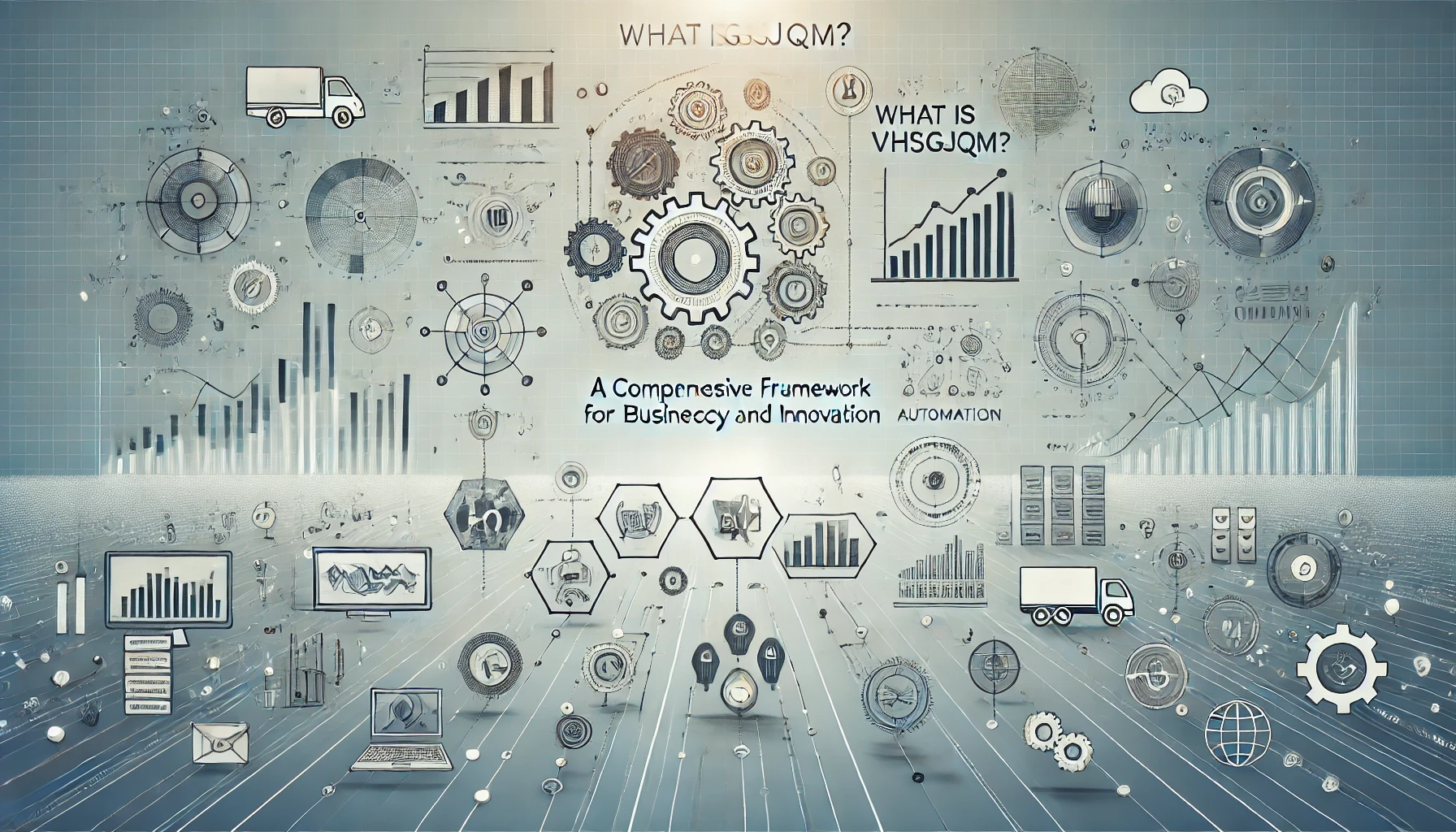VHSGJQM is an advanced business framework that focuses on improving operational efficiency and streamlining processes across a wide range of industries. Designed to integrate modern technologies such as Artificial Intelligence (AI), the Internet of Things (IoT), and advanced analytics, VHSGJQM offers a structured approach that enhances productivity, reduces waste, and drives innovation. Unlike other popular frameworks like Agile and Lean, VHSGJQM provides a more systematic and adaptable method, making it a vital tool for businesses aiming to excel in a competitive, digital-driven environment.
What is VHSGJQM?

VHSGJQM is a business framework that brings together various modern technologies and practices to create an optimized, efficient, and adaptable approach for managing operations. It focuses on continuous improvement and is structured to be applicable across multiple sectors, such as healthcare, manufacturing, and energy. By combining elements like automation, data analytics, and process management, VHSGJQM helps businesses streamline their workflows, enhance productivity, and reduce operational costs.
The name “VHSGJQM” represents a methodology that emphasizes precision, adaptability, and innovation. Businesses that implement this framework can expect a more cohesive and integrated operational system, allowing for better resource management and improved decision-making.
Key Features of VHSGJQM
To understand the benefits of VHSGJQM, let’s look at some of its essential features and how they contribute to business efficiency:
1. Operational Efficiency

One of the primary goals of VHSGJQM is to boost operational efficiency. The framework enables businesses to optimize resource usage, ensuring that time, materials, and labor are utilized to their fullest potential. This is achieved through streamlined workflows and process automation, which reduce unnecessary steps and minimize waste.
For example, in manufacturing, VHSGJQM can help businesses manage inventory more effectively, reducing overproduction and ensuring that materials are only ordered when needed. In healthcare, it can optimize patient flow, making it easier for staff to manage appointments and resources, leading to faster, more efficient care.
Key aspects of operational efficiency under VHSGJQM include:
- Resource Optimization: Ensures that all resources are utilized effectively, minimizing waste.
- Cost Reduction: Reduces overhead costs by streamlining processes and eliminating inefficiencies.
- Productivity Enhancement: Encourages a smooth workflow, leading to faster task completion and higher output.
2. Automation and AI Integration
Automation is a core component of the VHSGJQM framework. By incorporating AI and machine learning, businesses can automate repetitive tasks, allowing employees to focus on more complex, value-added activities. This integration can be seen across various industries, from manufacturing to healthcare, and includes technologies like robotics, smart sensors, and intelligent systems.
- In Manufacturing: VHSGJQM facilitates automation in tasks such as quality control, assembly, and predictive maintenance. By using AI-driven tools, manufacturers can predict when machines might fail, enabling proactive maintenance that reduces downtime.
- In Healthcare: The framework integrates AI to support tasks such as advanced diagnostics, automated patient monitoring, and even administrative tasks like billing. This ensures healthcare providers can offer more personalized and accurate care while managing their resources effectively.
Automation under VHSGJQM not only improves accuracy but also speeds up processes, ensuring businesses can meet demand without compromising quality.
3. Versatility Across Sectors
One of the standout features of VHSGJQM is its adaptability. Unlike other frameworks that may be limited to specific industries, VHSGJQM can be customized and applied to various fields. Here are a few examples:
- Healthcare: The framework supports advanced diagnostics and patient care by integrating AI tools that analyze patient data to provide more accurate diagnoses and treatment recommendations. This can lead to quicker recovery times and a better patient experience.
- Energy Sector: VHSGJQM can be used to optimize the use of renewable energy sources, ensuring more efficient energy management. It helps energy companies reduce their carbon footprint by streamlining the distribution and consumption of energy.
- Supply Chain Management: In logistics and supply chains, VHSGJQM facilitates better tracking and automation of processes, from inventory management to order fulfillment, ensuring smooth operations across the supply chain.
Benefits of Implementing VHSGJQM
Businesses adopting the VHSGJQM framework can experience numerous advantages that contribute to their long-term success:

- Improved Decision-Making: By leveraging advanced data analytics, VHSGJQM enables companies to make more informed decisions based on real-time data. This leads to quicker adjustments and better strategies, ensuring companies can adapt to market changes efficiently.
- Cost Savings: With its focus on minimizing waste and optimizing resource usage, VHSGJQM helps companies cut down on unnecessary expenses. This allows businesses to allocate their budgets more effectively, investing in areas that yield higher returns.
- Enhanced Customer Experience: Whether it’s faster product delivery, accurate diagnostics, or improved energy management, the efficiency driven by VHSGJQM translates into a better experience for end-users. This not only boosts customer satisfaction but also enhances brand reputation.
Challenges of Implementing VHSGJQM
While VHSGJQM offers numerous benefits, businesses may face some challenges during implementation. Understanding these obstacles can help companies plan more effectively:
- Cost of Implementation: Integrating VHSGJQM can be an expensive endeavor, especially for smaller businesses. The cost of new technologies, software, and training can be high, and companies need to assess their budgets carefully before committing.
- Data Privacy Concerns: With the integration of AI and IoT, a significant amount of data is collected and processed. Businesses must ensure they have robust data privacy measures in place to protect sensitive information, especially in sectors like healthcare, where data security is paramount.
- Training and Adaptation: Implementing VHSGJQM requires employees to adapt to new systems and processes. This means businesses need to invest in training programs to ensure a smooth transition. Without adequate training, the potential benefits of VHSGJQM could be undermined by a lack of understanding and skill.
The Future of VHSGJQM: A Continuous Improvement Approach
One of the core principles of VHSGJQM is its emphasis on continuous improvement. Unlike static frameworks, VHSGJQM is designed to evolve as new technologies emerge. This adaptability ensures that businesses can stay competitive by integrating the latest advancements, from more sophisticated AI systems to next-generation IoT devices.
As industries continue to digitize, VHSGJQM’s structured yet flexible approach will be crucial for businesses looking to stay ahead. For instance, the future may see deeper integration of blockchain technology for more secure transactions and data exchanges, or further advancements in machine learning for even more refined automation.
The adaptability of VHSGJQM ensures that businesses are not just implementing a framework but adopting a mindset geared towards innovation and progress.
Conclusion
VHSGJQM represents a modern and structured approach to enhancing business efficiency. By integrating advanced technologies like AI, automation, and analytics, it provides a comprehensive framework that boosts productivity and optimizes processes across various sectors. Whether in healthcare, manufacturing, or energy, VHSGJQM’s versatile and adaptive nature ensures that it can be tailored to meet the unique demands of different industries.
Despite challenges such as implementation costs and data privacy concerns, the benefits of improved decision-making, cost savings, and enhanced customer experiences make VHSGJQM a valuable tool for companies striving for excellence in a digital, data-driven world. As businesses continue to adapt and grow, VHSGJQM’s focus on continuous improvement will play a critical role in helping them stay competitive and efficient.
For more detailed information about frameworks like VHSGJQM and their applications, you can explore the concept of business process management on Wikipedia.
Here is Our Latest Article: What is Fameblogs net? Your Ultimate Guide to Lifestyle Trends, and Business Insights
